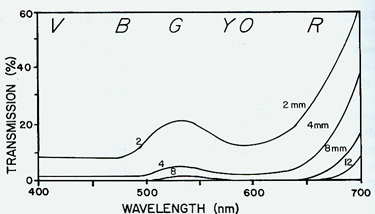Transmission Curves for Different Thicknesses of Tourmaline | |
 Reprinted with permission of Dr. Kurt Nassau | |
| "At thicknesses up to about 4mm, as in the upper two curves, the high sensitivity of the eye to the central green region of the spectrum results in a dominant green perception from the broad transmission near 530 nm. The even stronger transmission at the red end of the spectrum is perceived at much lower sensitivity, as deduced from the above figure, and acts simply to change the perceived color to a yellowish green. When the thickness is increased to 8 mm, the green transmission band has become very weak, while the red band retains significant intensity, so that both are perceived about equally, resulting in a yellow color. By 12 mm the red band fully dominates, leading to the red color." (Nassau, Kurt. (2001) The Physics and Chemistry of Color: The Fifteen Causes of Color. 2nd edition Wiley Interscience, Chichester. pp 95-96). Please note: this data represents a certain selection of the tourmalines in the second study published in 1999 Colour hue change of a gem tourmaline from Umba Valley, Tanzania. As Asbjørn Halvorsen pointed out, this change with thickness is dependant on concentration of the elements chromium and vanadium. Therefore, these transmission curves may not be the same for similar thicknesses of other samples with slightly different compositions. | |
| Back to Usambara Effect Main Page or Usambara Study Results or Transmission Absorption Curves | |